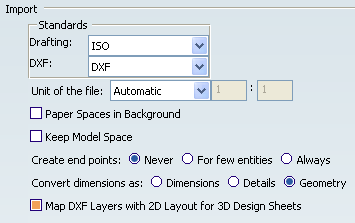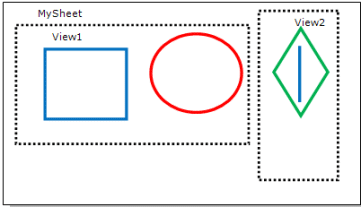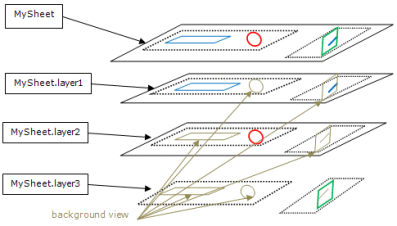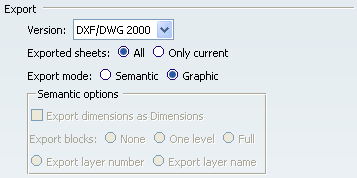DXF | ||
| ||
Import

- Drafting
-
The file you import is placed in a Drawing Representation. This
Drawing Representation uses styles defined in a pre-defined or a
customized standard such as ISO, JIS, ANSI, ASME. The
Drafting list lets you select this standard.
Note:
- The content of this list depends on which standards have been created and/or customized by your administrator.
- V6 determines systematically and automatically the most suitable
format (A0 ISO, A1 ISO, etc.) for each sheet (layout) i.e. V6
chooses the smallest format in which the drawing can be totally
included.
- If the standard is ISO, V6 chooses the format among A0, A1, A2, etc.
- If the standard is ANSI, V6 chooses the format among A, B, C, etc.
- If no standard format fits the sheet, the format is set to the largest one i.e. A0 ISO and made invisible with a message "No standard format can be applied to this sheet" in the report file.
- In export/import loops, the automatic determination of the standard may lead to format changes.
- If you are not satisfied with this automatic result, use the Page Setup command to modify the format.
Information on what has been determined automatically is written in the report file.
For more details about Drafting standards, please refer to Administration Tasks in the Interactive Drafting User's Guide.
 By default,
Drafting is set to ISO.
By default,
Drafting is set to ISO.
- DXF
-
Some AutoCAD attributes do not exist in V6 as such and require a mapping:
- AutoCAD color can be mapped to V6 line thickness,
- AutoCAD line type is mapped to V6 line type,
- AutoCAD text font is mapped to V6 text font.
These mappings are defined in a DXF standard file, which you can select from the DXF list.
 By default,
the value is set by your administrator: the content of this list depends on which standards have been
created and/or customized by your administrator.
By default,
the value is set by your administrator: the content of this list depends on which standards have been
created and/or customized by your administrator.
- Unit of the file
-
When the option is set to Automatic, the unit of import is determined automatically (either millimeter or inch) for the best possible resulting drawing.
However, in some cases the resulting drawing is not satisfactory and requires another unit. Select this unit in the list, then restart the import.
If you have selected Scale Factor, enter the value of the scale factor between the imported file and what you want to get from the original Drawing in the fields on the right.
 By default,
Unit of the file
is set to Automatic.
By default,
Unit of the file
is set to Automatic.
- Paper Spaces in Background
-
The Interactive Drafting workbench provides a simple method to manipulate a sheet. A sheet contains:
- a main view: a view which supports the geometry directly created in the sheet,
- a background view: a view dedicated to frames and title blocks,
- interactive or generated views.
An AutoCAD file is usually made of:
- a model space that contains the geometry,
- a paper space (or several in AutoCAD 2000). AutoCAD recommends that the paper space contains the title box and one or several viewports (A viewport is a window to the model space). However other configurations are possible.
Select this option to put the paper spaces in the background view. The viewports are created in the working view.
 By default,
Paper Spaces in Background is not selected.
By default,
Paper Spaces in Background is not selected.
- Keep Model Space
-
Select this option to keep the entire model space in its own sheet.
If the option is not selected:
- When the model space is referenced at least partially by one or several viewports, it is not created in its own sheet. Only layouts are created. They contain eventual viewports. In this case, select the Keep model space to force the creation of the model space in its own sheet.
- When the model space is referenced by no viewport (or if there is no viewport in the DXF file), it is created in its own sheet (unless it is empty).
Important: Viewports with a not null twist angle (group code 51) are not correctly handled during import. If the option is selected:
- The model space is created in its own sheet (unless it is empty).
 By default,
Keep Model Space is not selected.
By default,
Keep Model Space is not selected.
- Create end points
-
It is not easy to modify and stretch geometry of imported elements the way you can do it in a V6 native elements. A solution is to create end points when needed, but to the detriment of performances. Create end points offers you three options to fit your needs:
- Never: ensures the best performances.
- For few entities: creates end points only for hatch boundaries and mixed polylines. This is an intermediate choice between performances and edition capabilities.
- Always: creates end points for arcs, ellipses, lines, mlines, leaders and not standard polylines and splines. Use this option only when edition capabilities are required.

 By default,
Create end points is set to Never.
By default,
Create end points is set to Never.
- Convert dimensions as
-
Select the required option:
Dimensions: preserves the semantic of AutoCAD dimensions in V6 as best as possible.
- In most cases, the whole semantic of the dimension is kept. This means the position, the layout and the text are preserved. The position, color, thickness, text caption (symbol, value, tolerance, font, color) can be edited.
- In some cases, text with redundant information (e.g. tolerance present both in the dimension field and in the dimension text) or dual dimension, or other unrecognized information is dealt with as a text with an associative link with the dimension. This dimension has a "fake value" that is blanked. To display the true dimension value, delete the associated text and enter the data in the properties of the dimension.
Geometry: keeps the graphical aspect. Geometry is exploded into multiple lines, arcs, texts. (this mode increases performance when loading a model).
Details: turns dimensions into details. This is an halfway notion between the previous two, in which the geometry is preserved and the dimension is easy to handle (it can be all selected at once).
Important: with the Dimensions option: - Problems may occur while positioning texts for Angular dimensions
- Following attributes are not yet supported :
- suppression of one of the dimension lines (for half dimensioning),
- offset extension or suppression of extension lines,
- arrowhead choice (the V6 default arrowhead is used),
- automatic suppression of arrowheads if space is not sufficient.
 By default,
Convert dimensions as is set to Geometry.
By default,
Convert dimensions as is set to Geometry.
- Map DXF Layers with 2D Layout for 3D Design Sheets
- This functionality is available only for 2D Layout for 3D Design workbench, using Import From File... command. When selected, it maps geometries and annotations with 2D Layout for 3D Design sheets, from the number of the layer the geometries and annotations belong to.
Note:
- Clipping views are not taken into account .
- An invisible layer in DXF drawing is imported as a Layout sheet with its visualization status set to Hide in 3D.
Example:

- Entities in layer1 are in blue,
- Entities in layer2 are in red,
- Entities in layer3 are in green.
In this example, the DXF Layout is imported in 2D Layout for 3D Design with 4 Layout sheets. The views of the first layout sheet have a display of the corresponding view on the different layout sheets.

- The name of the other layout sheets are: "initialSheetName" + "." + "layerIdInDxfFile"
- Each DXF sheet is converted into a Layout sheet containing as many views as there are viewports in the original sheet. Those views are created with entities belonging to layer none ("0" ). If the layer none contains no entity, the view is created empty.
- For each layer used in the original layout, an additional Layout sheet is created, containing the same views. DXF geometries and annotations assigned to this layer are converted into V6 elements in those views.
- For each view, a display filter is created. This same filter is applied to each view of all the Layout sheets (corresponding to all layers, including the layer none).
- With a filter on the first Layout sheet, visualization is equivalent to the original DXF
file.

- For a view, the name of this filter is: "MySheet.Name_of_View".
- The background visualization of all views in sheet "Mysheet" is set to Standard. The background visualization of all the views in other sheets corresponding to other layers is set to Low-intensified.
- If the data are imported with the option Keep Model Space, the Model Space is imported like another independent layout with one Main View. A filter Model is defined and give a display on each Main View of the different layouts. All entities in Model.1 are in layer1, All entities in Model.2 are in layer2, …
- Entities in paper space have a layer number. They are created in the corresponding layout.
- Layers on Details are not concerned by this dispatch of sheet.
 By default,
Map DXF Layers with 2D Layout for 3D Design Sheets is selected.
By default,
Map DXF Layers with 2D Layout for 3D Design Sheets is selected.
![]()
Export

- Version
-
Select the required export file format from the list.
DXF/DWG formats version 12, 13, 14, Autocad2000, Autocad2004 and Autocad2007 are supported.
DXF/DWG 2000 is used by AutoCAD 2000, 2000i, 2002
DXF/DWG 2004 is used by AutoCAD 2004, 2005, 2006
DXF/DWG 2007 is used by AutoCAD 2007, 2008
 By default,
Version is set to DXF/DWG 2000.
By default,
Version is set to DXF/DWG 2000.
- Exported sheets
-
Select the required option to export either all sheets or only the current sheet of a multi-sheet drawing.
- Only current exports the data to a file with the name entered in the Save as dialog box.
- All exports the data to several files. The name of each file is made of the name entered in the Save as dialog box and the name of the sheet (Drawing1_sheet_1.DXF, Drawing_sheet_2.DXF, ...).
 By default,
Exported sheets is set to All.
By default,
Exported sheets is set to All.
- Export mode
-
This option offers the choice between two export modes:
Graphic: This mode is quick and reliable. It is useful if you want to export a Drawing to AutoCAD and print it without modifying it.
Semantic:
- The exported file can be modified.
- Dimensions are exported as subfigures and are editable as such. Dimensions that cannot be exported semantically are exported as subfigures.
- Half-dimensions and chamfer dimensions are exported as subfigures.
- Circular, linear and angular dimensions are exported as true dimensions and editable as such.
- The texts of those dimensions are exported with the STANDARD style and the isocp.shx font.
- The tolerances of dimensions are exported.
- The "upper" and "down" texts are not taken into account.
- Dual values are not exported.
- Circular extension lines are not exported.
- Show/No Show: The V6 elements placed in the No Show are not exported. The visible elements are exported.
- Layers are automatically exported.
- To avoid missing geometries at export, we recommend that you activate either the filter All Visible or the filter None.
- Texts:
- All texts are exported as texts (even dimension texts and annotations) with a fit justification,
- All texts are exported with the STANDARD style and the isocp.shx font with the exception of geometric tolerance symbols that are exported with the GDT specific style and gdt.shx font, with the corresponding mapping.
- The symbols for diameter, degree and plus/minus are inserted with the standard tags.
- Unicode characters are exported with the \U+ tag. You have to redefine the STANDARD style in AUTOCAD to reference an unicode font.
Note: for both modes:
- If the sheet to export contains no geometry, or only non supported entities, no DXF/DWG file is generated.
- The visual clipping of views is not supported.
- The point of view (camera) of the model is not exported.
 By default,
Export mode is set to Graphic.
By default,
Export mode is set to Graphic.
- Semantic options
- Those options become active when Semantic is selected.
- Export dimensions as Dimensions
- If the check box Export dimensions as Dimensions is not selected, all dimensions are
exported as graphic blocks and are editable as such.
If the check box Export dimensions as Dimensions is selected, dimensions are exported as follows:
- The graphic representation is always created in addition to the semantic representation. Thus when opening the result with semantic dimensions with AutoCAD, the graphic representation is first kept but the dimension may be rebuilt at any edition, while taking into account the default dimension style.
- Default dimension style entails that most graphic attributes (such as color, display format of the dimension value, type of arrow, space...) of the dimensions are lost. The default dimension style depends on the current export unit (INCH, mm,...).
- Horizontal and Vertical projected linear dimensions are created as DXF "rotated dimensions". If the attach points of the dimension are distant compared to the projected distance, there may be a numerical error in the measured dimension. If this occurs, reduce the number of digits displayed in the opening system.
 By default,
Export dimensions as Dimensions is not selected.
By default,
Export dimensions as Dimensions is not selected. - Export blocks
- Those three options define how blocks are exported:
- None: with this option, the export does not create any block in the DXF/DWG file.
- One level: Details are retrieved through their Dittos. A Detail not referenced by a Ditto is thus lost, a Detail referenced by several Dittos is duplicated in BLOCKS. The entities included in a Detail are not structured into sub-blocks. The graphical representation of each Ditto is exported to an INSERT/BLOCK.
- Full: Each Detail instantiated by a Ditto
inside a sheet is translated as such. If necessary, the name
of the Detail changes according to the following rule:
- If the V6 Detail name is an empty string, the name of the corresponding BLOCK is BLOCK_EMPTY_NAME_ followed by a number to guarantee the uniqueness of the name (whatever the Version might be).
- If the V6 Detail name is not en empty string, and if Version is set to DXF/DWG R12/R13/R14, only the first 20 characters are exported (f required, they are followed by an underscore '_' and a number to guarantee the uniqueness of the name). The only characters exported are letters (from 'a' to 'b' and from 'A' to 'Z') all converted in upper case, digits (from '0' to '9') and the following special characters: the hyphen '-' and the underscore '_'. All others characters are exported as underscore '_'.
- If the V6 Detail name is not en empty string, and if Version is set to DXF/DWG 2000 or higher, only the first 250 characters are exported (if required, they are followed by an underscore '_' and a number to guarantee the uniqueness of the name (with the same constraint about characters as above except that lower case letters are not modified in uppercase letters).
Details which are not directly defined inside the Drawing representation (e.g. coming from a catalog) are exported as one INSERT/BLOCK per Ditto visually faithful.
For each supported Detail:
- Ditto is positioned inside the Sheet coordinates system according its insertion point and its transformation.
- The graphical properties (color, line type, line thickness) of each Ditto are visually kept (no overload will be seen).
- The Detail entities keep their layer according to the DXF layer semantic export option (the name or the number is exported).
- Contained geometric entities like Nurbs, Spline or ellipse are exported semantically (not as polylines).
- Nested Detail are exported as such.
- Invisible entities are not exported.
- Only the Detail instantiated inside the sheet are exported.
- The number of exported entities is written in the report file. One export Detail corresponds to only one BLOCK with as many INSERTS as exported Dittos.
 By default,
Export blocks is set to One level.
By default,
Export blocks is set to One level. - Layers
- The two following options deal with the export of layers.
With the exception of the None layer, each V6 layer is defined by three data:
- Its number,
- An optional name,
- An optional comment.
In AutoCAD applications, layers are defined by:
- a name,
- a status,
- some graphical attributes.
You can choose how you want to export layer number:
- Export layer number: Each V6 layer is exported with an AutoCad layer name that is the number of the V6 layer
- Export layer name
- If the V6 layer name is an empty string, the V6 number is exported (whenever the AutoCAD export version chosen).
- If AutoCAD R12, R13 or R14 is selected as the export version,
then only the first 26 characters are exported.
The only characters exported are:
- letters (from 'a' to 'b' and from 'A' to 'Z') all converted in upper case,
- digits (from '0' to '9')
- and the following special characters: the hyphen '-' and the underscore '_'.
- All others characters are exported as underscore '_'.
- If AutoCAD 2000 or a version above is selected as the export version, then only the first 255 characters are exported, with the same constraint about characters as above, except that lower case letters are not changed to uppercase letters and space character is authorized.
- Some different layers could be translated into the same AutoCAD Layer. When this case happens a message is added inside the report file.
 By default,
Export layer number is selected, Export layer name is not selected.
By default,
Export layer number is selected, Export layer name is not selected.